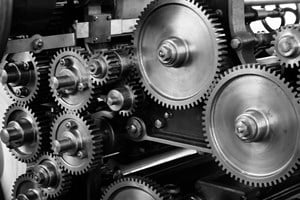
The Use of Case Hardening to Improve Wear Resistance in Metal Components
Posted on February 15, 2019 in Blog

Case hardening is a heat-treating process that optimizes wear resistance of a manufactured part or component while minimizing the piece’s fragility and failure. Manufacturers in a range of industries such as aerospace, automotive, and oil and gas use case hardening furnaces. Objects or parts like firing pins, screws, lock shackles, chains, and camshafts that are likely to experience high pressures and sharp impacts are case hardened. Components like ball bearings, shafts, and gears that rotate are also put through a case hardening process to help prevent rolling contact fatigue and spalling.
In rolling contact fatigue, miniature cracks develop just below the surface of the object. Continued use of the part or component causes the cracks to work up towards the surface. Pits form as the cracks reach the surface and these pits can lead to spalling, which occurs when pieces of metal flake off the component. Pitting also causes the component to vibrate, and vibrating components are louder and can potentially lead to equipment breakdown and failure.
Heat treating these metal components can prevent rolling contact fatigue, but the process can also make components more brittle, which causes an entirely new set of problems. Case hardening is used to prevent brittleness in heat treated metal.
What is Case Hardening?
As its name suggests, case hardening creates a hard case around the outer layer of a metal component. The technique creates a wear-resistant exterior coating that helps protect the softer interior of the metal component. Case hardening leaves the inner layer of the component pliable and preserves the interior’s ductile strength. The thickness of the hardened layer is referred to as case depth.
Common case hardening methods are atmosphere carburizing and vacuum carburizing. Carburizing introduces carbon to the metal to increase the metal’s hardness. It is typically used on metals containing very low carbon counts, below 0.3 percent. Atmosphere carburizing involves heating the components in a pit furnace or sealed atmosphere furnace then, at the desire temperature, introducing methane, carbon monoxide, carbon dioxide or other carbon-containing gases. The gases are then absorbed from the outside of the metal inward. Rapid cooling through quenching changes the structure of the treated metal and increases its hardness. Vacuum carburizing is similar but involves heating the steel in a vacuum environment.
Case hardening furnaces are used for this heat treat process. Lindberg/MPH designs and manufactures heat treat furnaces for a variety of case hardening applications. A few units that are ideal for case hardening include the Integral Quench System, the HOMOCARB Pit Furnace, and the Corrtherm Element Electric Box Furnace. All of Lindberg/MPH’s case hardening furnaces offer a unique combination of high performance and low maintenance and allow manufacturers to optimize resistance and reduce failure in large and small metal parts and components.
Be sure to like Lindberg/MPH on Facebook and follow us on LinkedIn. Check back in here each month for our latest blog post. Be sure to check back next month for our blog about the relevance of the foundry industry in manufacturing!

